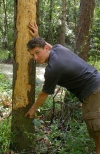|
Foraging marks on
freshly dead trees
In Louisiana, Ivory-billed Woodpeckers were reported to forage by
prying off sections of tightly adhering bark from the trunks of trees
that had recently died. Many species of woodpecker will feed by
probing under bark, but the bills of Ivory-billed Woodpeckers are large
and flattened at the tip allowing them to strike thick strong bark
cleanly away from the sapwood.
Throughout our study area along the Choctawhatchee River we observed
sections on the trunks of freshly dead trees where tightly adhering
bark had been scaled from large trees. This bark scaling was
unlike woodpecker foraging sign that we observed in other southern
forests. In many instances, such bark scaling revealed large bore
holes of beetles. Spruce pine and sweet gum seemed to be the tree
species that were most often scaled in this manner. In attempt to
quantify the uniqueness of the bark scaling that we observed along the
Choctawhatchee River compared to what we observed in other southern
forests we compared the adhesion of the bark on woodpecker foraging
trees in our ivorybill study site and to the adhesion of bark on
woodpecker foraging trees in three creek bottoms around Auburn, Alabama
where ivorybills almost certainly do not occur. For this comparison, we
did not just choose the “best” trees on our Florida site. Within
a patch of forest we measured bark adhesion on all trees greater than 4
centimeters DBH that had signs for woodpecker foraging. The bark
adhesion on scaled trees along the Choctawhatchee River was
significantly stronger than bark adhesion on trees around Auburn.
The mean size of foraging trees in these samples was not
different.
A priority of future research will be to provide better links between
the scaled bark that we observe on trees along the Choctawhatchee River
and foraging ivorybills. If we can demonstrate that such foraging
sign is diagnostic of resident ivorybills, then a search for scaled
bark can be used as a fast and efficient means to search forested areas
for the presence of ivorybills.
|
|

|